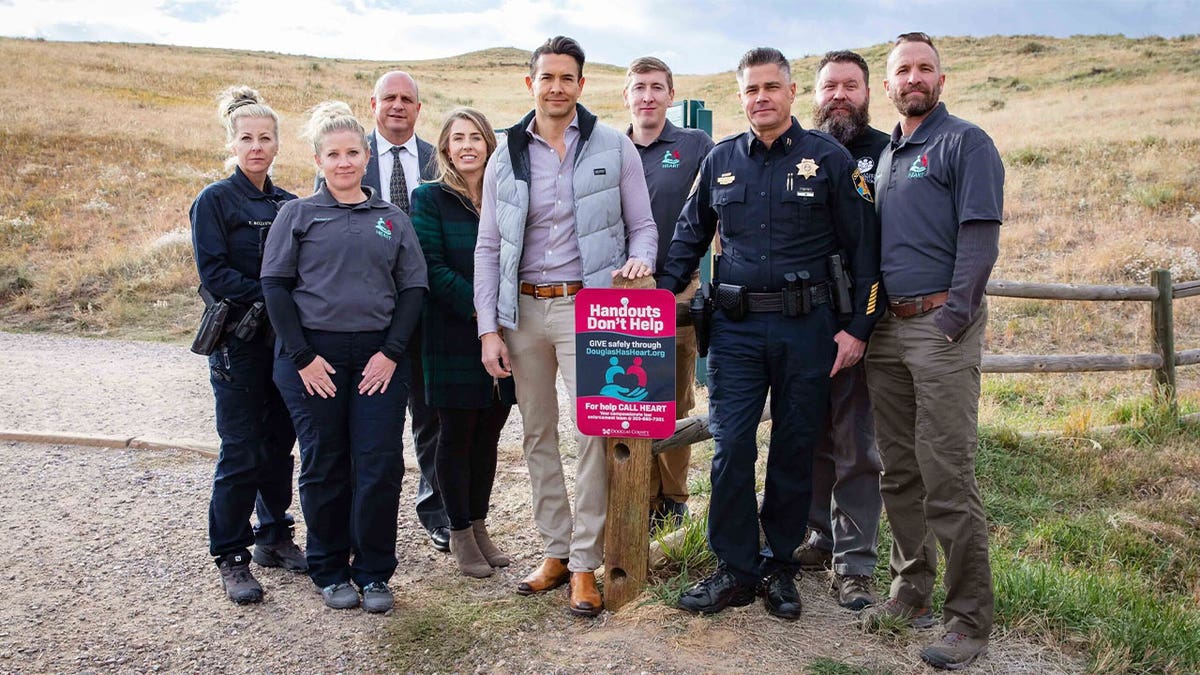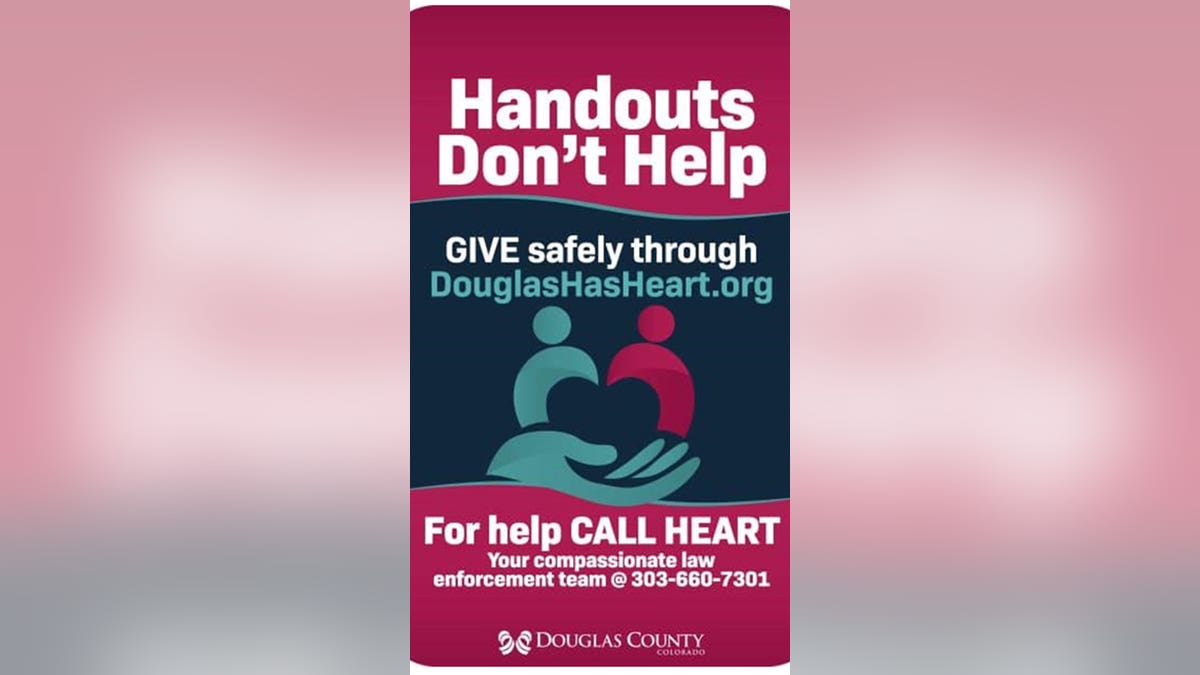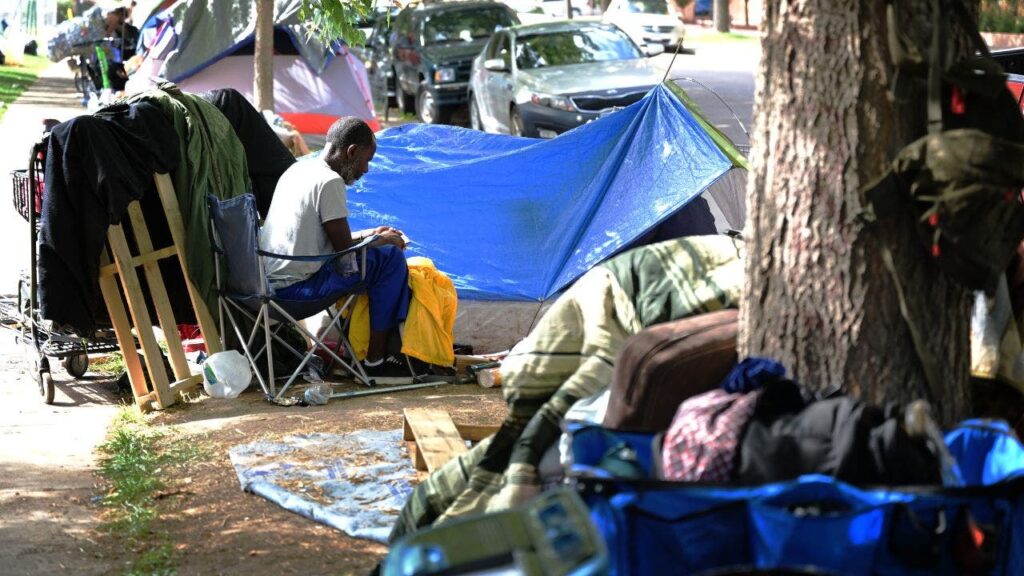Due south of Denver’s homelessness crisis, a Colorado county has nearly eradicated its own unhoused population with a simple message to its citizens: “Handouts Don’t Help.”
Throughout Douglas County, there are about 70 signs with the message at intersections and roadways that were once popular hangouts for area panhandlers. Each sign directs citizens to DouglasHasHeart.org, where they can redirect their donations to the Douglas County Community Foundation. The county took to print media and advertisements online to spread the message through the community.
“The thought dawned on me from a common sense standpoint – I saw a lot of people like my daughter feeling conflicted at an intersection,” Republican Douglas County Commissioner Abe Laydon said of the initiative.
“If you see someone who appears to be down on their luck, it feels bad when you drive by and don’t do something – but the flip side is we all know the stories of those who maybe did not use all the funds they received in the most appropriate way. Maybe it’s going to food, maybe it’s going to drugs – you don’t know where the money is going.”
DENVER MAYOR TOUTS ‘AMBITIOUS’ PLAN TO GET HOMELESS OFF STREETS, TAKE BACK DOWNTOWN FOR FRUSTRATED RESIDENTS

Douglas County Commissioner Abe Laydon, surrounded my members of the Homeless Engagement, Assistance Resource Team, holds one of many “Handouts Don’t Help” signs displayed around the county. (Provided by Abe Laydon)
“It seems like the more you give at those particular corners, the more people it attracts. It becomes a conversation topic on the streets – if you go to this corner, you’ll get money there,” he continued.
Now, Laydon said, intersections and street corners where the homeless once loitered are clear.
Between 2022 and 2024, Douglas County saw a steep drop-off in people living on its streets, from 43 individuals to just six, according to their most recent point-in-time count report conducted by several nonprofits. Including those sleeping in their cars and in area shelters, numbers decreased from 96 total homeless people to 69, per the count.
On that day, July 29, there were no panhandlers or encampments spotted throughout the county’s five jurisdictions.
Based on its own point-in-time counts, which include those housed in shelters and on the streets, Denver counted 9,065 homeless individuals in 2023, up from 6,884 counted in 2022.
“I saw it coming from Denver – people would get off the light rail, not pay for a ticket, get off at Long Tree,” Laydon said. “Next thing you know they’re asking for money on a corner.”
‘ECSTATIC’ DENVER MAYOR SAYS CITY TRANSFORMED BY PUSH TO HOUSE HOMELESS, BUT CRITICS SAY JOB ISN’T DONE

A homeless encampment in Denver on Aug. 23, 2023. (Hyoung Chang/The Denver Post)
Laydon said he first conceived of the “Handouts Don’t Help” concept when he was volunteering in the town of Lone Tree with his son and encountered a homeless encampment at the intersection of Lincoln and I-25 “littered with liquor bottles and drug paraphernalia.”
“It was kind of everywhere, but never as bad as downtown Denver – we started at a good place,” Laydon said. “[Our smaller homeless population] gave us the opportunity to nip this problem in the bud before it became really pervasive.”
Laydon said Douglas County’s Homeless Engagement, Assistance and Resource Team – which pairs behavioral health experts with area police officers in their interactions with the homeless – made 250 contacts with the homeless population when the initiative first started in 2022.
In five branded vehicles, the HEART Team approaches each homeless individual reported, offering them services to get back on their feet.
DENVER MIGRANT ADVOCATES SAY SIX MONTHS OF FREE RENT, FOOD NOT ENOUGH: ‘A SLAP IN THE FACE’ AND ‘OFFENSIVE’

Pictured is one of Douglas County’s signs redirecting citizen’s donations from panhandlers to the county fund. (Douglas County, Colorado)
“If people need services, they’re getting them. They’re getting hotel vouchers, we’re partnering with Ready to Work,” Laydon said. “If somebody needs a job, they will get one. If they need a bus ticket back to their family in Tennessee, we’ve done that. If someone needs food for a night or a week, they’ll get it.”
If the homeless refuse help, HEART team navigator Tiffany Marsitto said, their team keeps trying.
“I had an individual who was service resistant in the beginning during our first couple of interactions. He was going through a mental health crisis. [Four months later], when he was ready to reengage with our team we were there for him. We helped him fill out an application for a housing opportunity in the Metro region,” Marsitto said.
“People may not be ready today but could be ready in the future,” she said. “They see our face, they know that we’re there and they know that our team cares. They know that our community cares about them, us continuing to engage with these folks goes a long way.”
Moreover, camping is illegal in Douglas County – the HEART Team said they don’t often issue tickets, but instead use this to encourage their contacts to check into area homeless shelters.
“Our goal is compliance, to use the ordinance to get the unhoused individuals to find a better solution,” HEART team navigator Rand Clark explained. “Very rarely does someone want to intentionally break the law. We’ve been able to use that tool from a positive perspective, to say that our county ordinance is that you maybe can’t sleep here, so how can we help you find a shelter in a place where you want to be and are not breaking the law.”
However, Laydon said, “illegal activity is illegal activity, whoever you are.”
“If you are urinating, defecating outside, doing drug deals in our light rail system, it doesn’t matter if you have a home or not – you’re going to get arrested,” he told Fox News Digital.
Thus far, the Douglas County Community Fund has received $11,000 in donations, many from citizens who saw their signage. The Douglas County Homeless Initiative, which includes HEART, was funded with federal American Rescue Plan funds rather than tax dollars.
The “Handouts Don’t Help” initiative, Laydon said, could “be done everywhere from main street to Wall Street.”
“It is a behavior change that is systemic that could stem the tide of homelessness in every community throughout the country,” he said.
When asked whether such an approach could curb homeless populations in Denver, Colorado Coalition for the Homeless chief communications and public policy officer Cathy Alderman was less hopeful about the prospect.
“We applaud any jurisdiction working to address homelessness, but as they do not provide shelter or robust services, and we know they are bussing people to other cities and counties for help, it’s hard to believe that being unwelcoming to people experiencing homelessness is a true solution to the problem,” she wrote via email.
https://www.foxnews.com/us/blue-state-county-bucks-trend-handouts-homeless-population-craters


